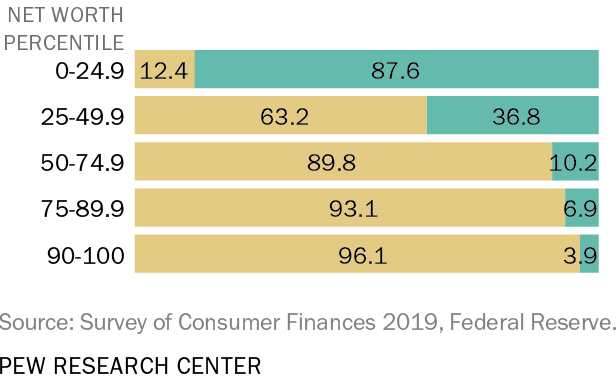Another Look at the Bottom-50% Wealth Runup: Meh
Wealth concentration got just a tiny bit less extreme
The bottom 50% of American wealtholders got richer in the last three years: in 2021, ’22, and ’23 — not just in absolute dollar terms, but relative to richer folks. The percentage growth was faster than it was for wealthier groups, so wealth inequality went down — but only by a smidge.
The first thing to know is that the Bottom 50 start 2021 with a pretty tiny slice and share of total assets: $7.8T, 5.6% of households’ $140T total. End of 2023, they’ve got $9.6T, 5.8% of the total.1 A welcome development, but not exactly a massive shift in wealth inequality.
But still, the Bottom 50% is a bit better off, in both relative and absolute terms. Where did that wealth come from? What kind of assets did the bottom 50% accumulate? Here you go:
Start with the righthand column. 84% of the total asset increase came from real estate and consumer durables (mostly vehicles). Stock-market holdings (in Other, which is mostly pension entitlements for this group) are a nothingburger for the bottom half of American households.
Real estate is easy to explain; real-estate prices went up. So the bottom-50%ers who owned their homes got richer. I don’t know what percent of bottom-50% wealthholders own their homes, but I’m guessing it’s a low number. (Help from my gentle readers much appreciated; I’ll update this.) If I’m correct, a big percentage of the Bottom-50 group received no benefit at all from that.
The bottom-50% renters are actually worse off, if they aspire to be homeowners.
Update June 17: pyradius on xwitter sent me this from here. (Thanks!) Homeowners vs renters, as a percent of each group.
For bottom-25% households, 88% received no benefit from the real-estate runup, while they’re facing much higher home prices if they want to get on the property-income escalator. A good example of averages hiding important details. /update
Durable goods requires a bit more explanation. What happened: people bought lots of new cars, trucks, and other durables. So their durable-asset holdings increased. This is not “free magic money” like real-estate holding gains, which just…happen.
Now you might say that the money to buy all those durables came from the stimulus checks, and from the covid Child Tax Credit expansion (all blessings on its brief life, and curses on its hasty demise at the hands of Republican congresscritters). Accept that and fine, sure, those durables came from “free money” as well.
But in any case, the much-heralded and certainly welcome bottom-50% en-wealthification was miniscule in both absolute and relative terms. And it was heavily skewed toward the (wealthier) homeowners in that group.
All the numbers here are from the Distributional Financial Accounts.




